THE 2018 COMEL AWARD FINALISTS
Laura De Lorenzo
Rome, ITALY
www.lauradelorenzo.it
www.lauradelorenzo.it
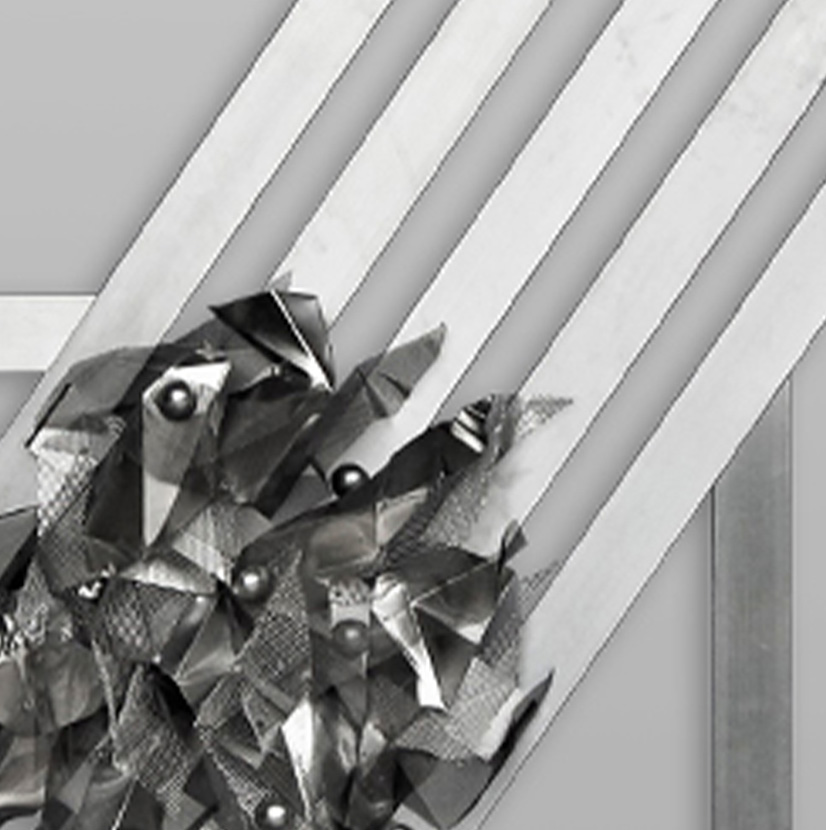
THE 2018 COMEL AWARD FINALISTS
Laura De Lorenzo
Rome, ITALY
www.lauradelorenzo.it
www.lauradelorenzo.it
BIOGRAPHICAL NOTES
She is an architect, designer, curator of major exhibitions, and musician. Her most important exhibition, “Pittura e Materia” (2005), was held at the National Gallery of Modern Art in Rome, curated by Maurizio Calvesi and Vice-Superintendent Mario Ursino. She utilizes unusual, often recycled materials. Her training as an architect has guided her compositional skills and her long career in the field of industrial design, providing the technical tools for the processing. Aluminum, widely used in her design products, even with advanced technologies, such as tensile structures, is a material that particularly fascinates her, for its artistic-expressive qualities.
ARTWORK IN CONTEST
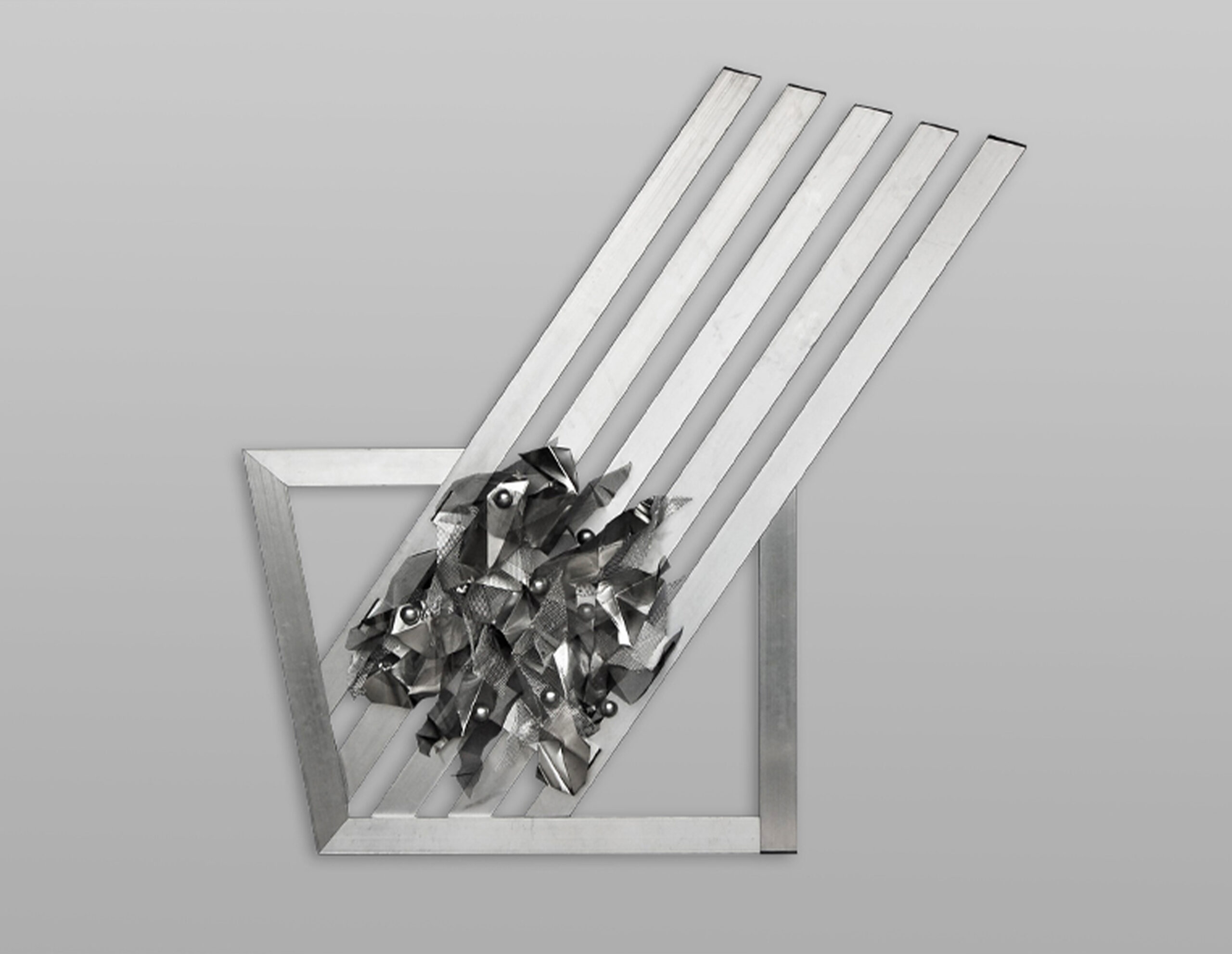
PIATTAFORMA AL-13, 2018
SCULPTURE - Aluminum sheets and nets various materials
cm 120 x 170 x 22
Her work enhances the aluminum in its specific peculiarities of ductile material, easily workable and arranged into a nice and charming colour rendering. Piattaforma AL-13 respects these characteristics, proposing the confluence of a constructivist language with a spontaneous and instinctive digression, where materials play a formal improvisation. The box bars act as a basic constructive element, whose modular expressiveness automatically fills the underlying narrative requirement. Without surrendering to the security of the geometric symmetry, however, the work focuses on a imbalance, exalting with a few gimmicks a sense of movement which makes intriguing the whole particularly. The central graft, finally, perpetuates attention to the movement, while risking the linguistic inconsistency, due to the hazard of a baroque weighting of the work. However, it is in this risk that, on the contrary, the work reveals itself. Thanks to the sensitivity demonstrated towards the pictorial peculiarities of aluminum, it shows an unexpected play of lights able to rebalance and systematize towards a positive overall resolution the whole structural machine.
Andrea Baffoni
AWARDS
SPECIAL MENTION OF THE JURY 2018
“In its structure, characterized by an elegant compositional essentiality and a fitting set of visual synthesis, constructive and planar dynamics coexist with pictorial effects entrusted to the ductile and sensitive qualities of the metal.”
(from the minutes of the jury)
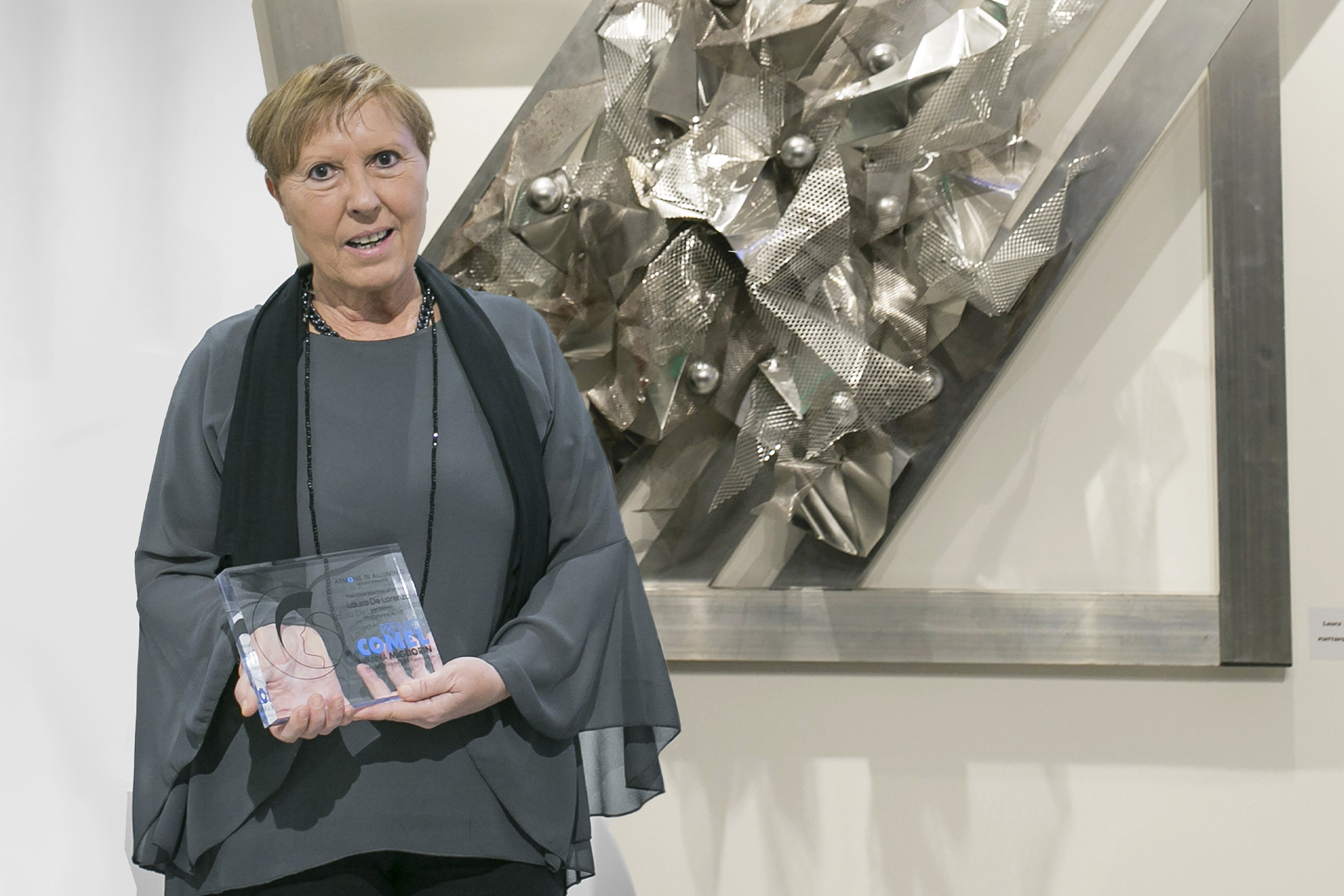
Interview by Rosa Mananuzzi
Architect, designer, organizer of major exhibitions, musician. Her most important exhibition "Pittura e materia" (2005), was held at the National Gallery of Modern Art "in Rome, curated by Maurizio Calvesi and by Mario Ursino as vice-supervisor. She uses unusual materials, often recycled. Her studies as an architect influenced her compositional skills and her long career in the field of industrial design, providing her the technical tools for processing different materials. Aluminum, in particular, is widely used in her design products, even with advanced technologies, such as tensile structures,it is a material that still fascinates her very much, for its artistic-expressive qualities.
Do you remember when you first decided to dedicate yourself to art? What was the spark? And what did you do to make your dream come true?
I think I was born with a certain tendency to creativity, which was already expressed in the games of the first childhood. In addition to performing in the usual "scribbles", I had a special relationship with toys and other things that I came into possession of and loved to collect. It was my mother, passionate about modern art, who led me to museums and it was then that I began to paint more seriously, taking the great artists of the '900 as models and reinterpreting their themes. I used to spend all my "pocket money" at the art framer shop and then I gave my small works to my mother. As long as she lived, I dedicated her all my creations. The visual arts - together with many other activities - have accompanied me throughout my life, but only in relatively recent times, I dedicated my full-time commitment to it. The actions taken were initially to join together with other aspiring artists, to understand the indications of important masters and curators and naturally to look for opportunities to exhibit, which, years ago, was much simpler.
The most important exhibitions include "Pittura e materia" (2005), held at the National Gallery of Modern Art in Rome, curated by Maurizio Calvesi a vice-supervisor Mario Ursino and the solo show "Meltin 'Pot", at Palazzo Chigi di Formello (RM), in 2014, curated by the supervisor of GNAM, Maria Vittoria Marini Clarelli. Two different periods of your career, probably marked by different expressive decisions. What are the connecting and breaking elements, if we consider these two moments?
The breaking point, which prevented me from collecting the benefits of the exhibition at GNAM, was a serious housing problem. Having lost, after long vicissitudes, my home-studio in Rome, I had to move to the countryside, which penalized my social relationships. My creative spirit though never dried up. After my set-up and graphic design at GNAM, I maintained good relations especially with the supervisor, who offered to take care of my solo "Meltin 'Pot" (2014), at Palazzo Chigi in Formello, an event that marked my return to the art scene. A very large exhibition, in which I was able to mend my path, placing some of my past works in the background, but giving more emphasis to those made with high-temperature treated plastic materials.
The critic Maurizio Calvesi, speaking of your bricolage, or object-characters, as he defines them, chose a poetic description and at the same time spoke of precise socio-psychological profiles: "[...] the angel who protests for the too narrow space in which it has been restricted, and the poor is despised by the magnet promoted to arch, full of haughtiness for the privileged place occupied by it with the sky in the background; the laundry table severely corrugated that orders "in line" the victim-laughing stock subjected to it; the torso without limbs that is teased by the mad myriad mad in a round dance of combs , glasses arms, padlocks, little circles and little stars that surround it mocking its immobility; the grids of New York-New York that boast faking skyscrapers, from grids to spiers; the spring that asks to be able to expand itself to drive away the other occupants of the roar; the unbearable stones of the too crowded prison that ask to be freed and to be able to spread freely on the ground. Listen to the crossing voices, [...] exiles of a lost totality, to whose expatriation you have given a new landing and a new context in which they can perform. "What do you see in the object that you find and to which you decide to give voice? Or is it the object-character that finds you so it tell its story?
The way Maurizio Calvesi managed to enter into my poetry and into my mind is extraordinary. Equally surprising is your intuition, when you ask me whether I want to give new life to the object or whether it is the object itself to propose to my attention to be saved from destruction and oblivion. I believe that in all the environmental contexts the objects, in use and not, are disposed, as if by chance, in spatial relations, which often has nothing to envy to many artistic compositions, giving life to that kind of art that I call "unintentional" . I recognize, I collect and catalog objects generally ignored by others. My archives of recovered objects and materials are immense and they there waiting to be transformed into workart. But I like to think that the objects themselves aggregate according to their own creativity, then trying to get noticed by glancing at the beach among the sand dunes, emerging from the asphalt of the streets, from the bottom of cellars or between scraps of building sites, leaving them magnificently degradeted from the weather or burnt by the sun. In reality it is, I believe they are lucky encounters: their task is showing their expressive potential, mine is to recognize it and insert it in my imagination, up to the point to crystallize the moment in which they assume spatial and conceptual relationships that I want to make real.
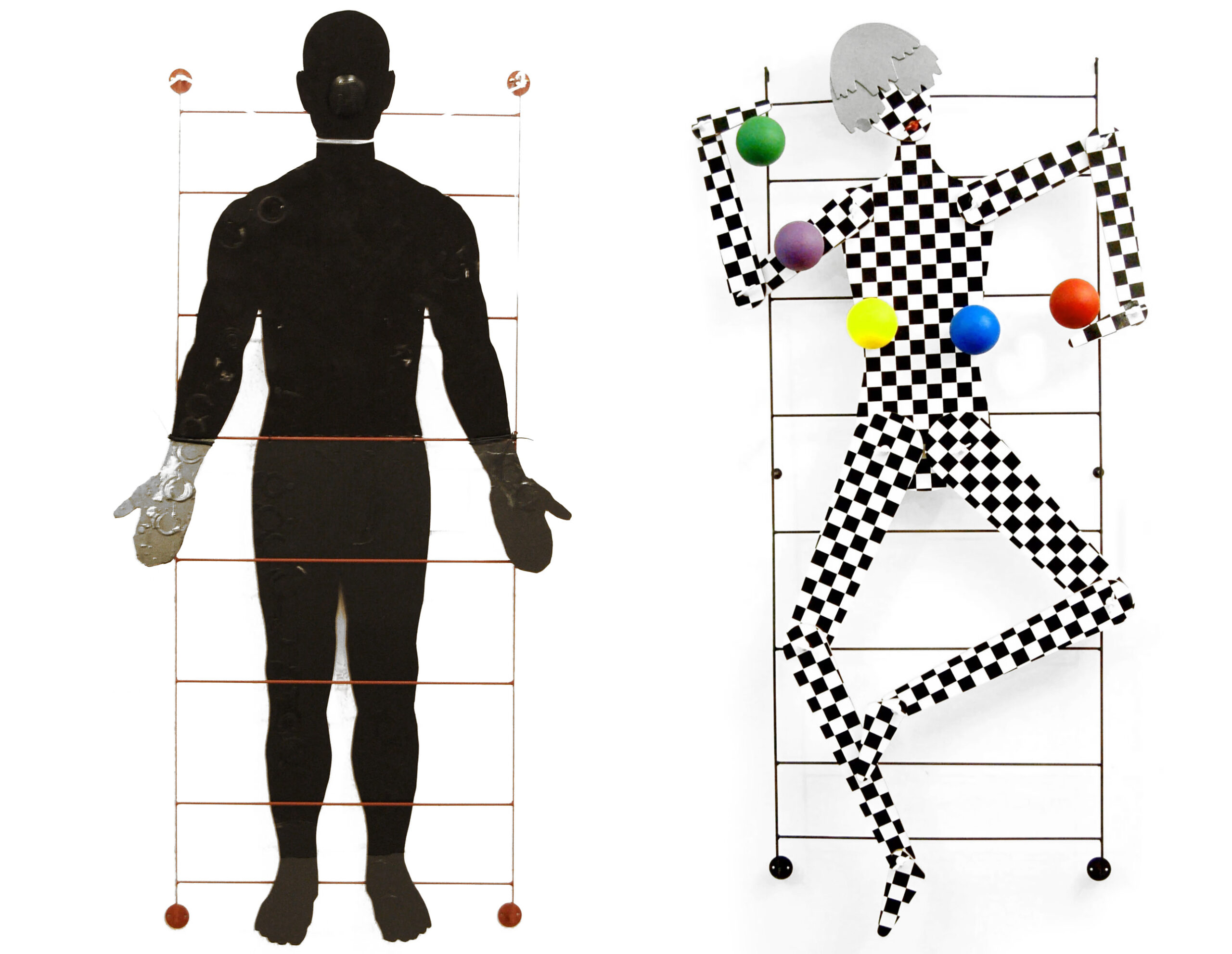
Prigione nero, 2014 (sx) e Giocoliera, 2014 (dx)
It seems to me that your disused objects are alive, with light, not their own (you light them up) and they are also equipped with a chromatic essence that makes them participate fully in your artistic action. The plastic is totally bent, transformed, regenerated. The artist recreates, highlights, exhibits. What do you feel in this task that is not simple at all and yet so similar to the original creation?
"light giver" is perhaps the best compliment I've ever received! Well to compare my task to the original creation (of which we know nothing actually), it seems to me to be a huge responsibility. However, as a passionate and strenuous student of quantum physics and current scientific conceptions of reality, I convinced myself that we are all creators: it seems that nothing exists except when the electromagnetic waves, vibrating, but mute and dark, of which the universe is composed, or rather the multiverse, materialize themselves and they are recognized by our senses. I believe, however, that the artist has the privilege of taking one more step: his is a creation into Creation. In fact, it gives life to something that without his intervention would not exist, not even in a virtual mode. Something not utilitarian, but that responds to a mysterious primordial instinct of communication. I believe that the artist ultimately expresses his own "ego" or rather the reflection that his conception of reality exerts on his conscience.
Since 2000, in your sculptures there is a lot of experimentation, in shapes and materials, and maybe even a certain degree of play. In your work art characters measure (as in La Giocoliera, 2014 and Prigione Nera, of the same year), they contain (in Il vuoto attira, 2002, Libro, 2003) or play in a light-hearted way and bring the unexpected into unlikely installations, like the cow on a skateboard ( in Ci provo?) which must go down by turning an angle of 90 degrees. How important is irony in art for you?
It is important to me in my job, but much more in my life in general. The irony and even more the self- irony are in my heart: someone who does not know how to catch a joke bores me, I dislike who does not accept word games, whether they are surreal or mischievous double meanings. I am also attracted by the absurd and the paradox and sometimes it happens that I pour them into my compositions, without premeditation though: it is always my "characters" who provide me with ideas. This is what happened for the small installation "Ci provo?" In which the old and battered wooden cow is struggling with skateboarding: a work art conceived as a joke, which, however, was apparently taken very seriously and rewarded in two competitions.
From 2016, your paintings become more articulated, but also more geometrically controlled. Shapes become symbols and are sometimes interrupted (Il passaggio, 2017), asymmetrical and blunt (Checkpoint, 2017) or lightened by colors, hot and cold, which manage to give life to a flat and dark surface (Cabrei I and II, 2017). Or the restlessness is confined to the circle (Restless White, 2017, Winter, 2017), and here it retains a pulsating activity that avoids the matter to amalgamate. Can movement and control find a balance?
I have always tried to overcome my instinct for balance and control, to exclude planning from the conception of the work. But evidently my training as an architect makes it difficult for me to express myself with the irrational impulsiveness I would like to have. However, since the mergers of plastics monopolized my attention, I was able to exploit their "anarchic" response to heat, to delegate much of the compositional result to chance. This resulted in art works in which the deep tangle and overlap of the material replaced the static nature, that I wanted to overcome, with restless movement .
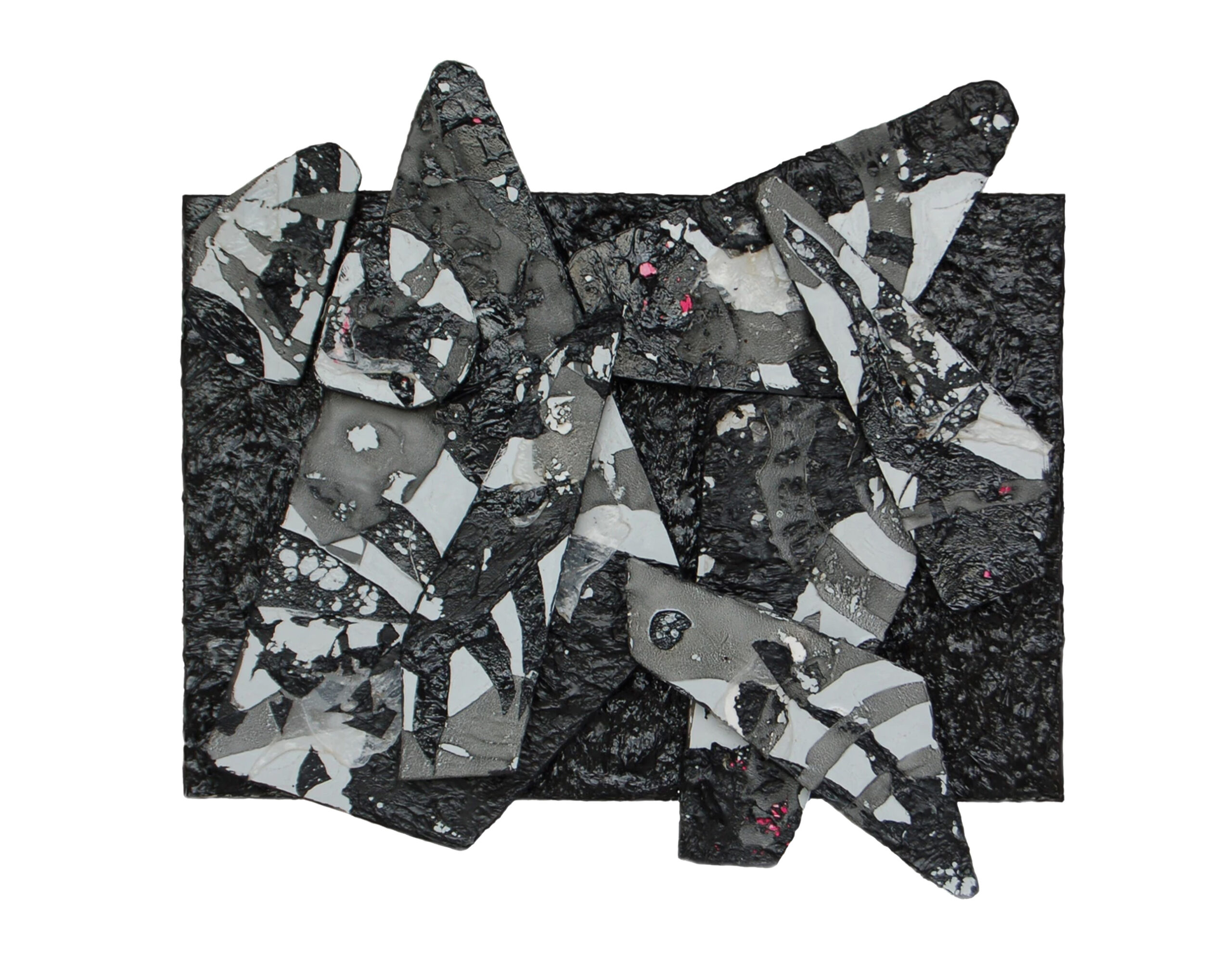
Checkpoint, 2017
You have developed a particular melting technique, in which the object is effectively melted. Thus it loses the aggregating properties that originally distinguished it. Therefore you create new matter with new chemistry. Yours is an almost alchemic transformation; I think of Pagina criptica, 2013, and even more conspicuously to the paintings called Meltin'pot, 2014. From these onwards the whole city melts under the artist's artifice, which disposes of it as a malleable place, imprisoning the darkness and embedding the light emerging from illuminated windows (or fiery red or silvery reflections on black). Melting pot as a crucible of what? What is the ideal society you love to show?
In the early works "melting", the enthusiasm to discover the response to the heat of plastics led me to create chaotic accumulations and unbridled color mixtures. Later my dark soul led me to favor gray-black castings and more complex compositions: the great permanent installation of 2015, at the MAAM, the Museum of the Other and the Elsewhere, founded in Rome by Giorgio Finis, is a significant example. Meltin 'Pot, a famous musical piece from the 1960s, was a hymn to the melting pot of races. Many of us dreamed of a world without borders and it is a thought that still attracts a lot of people. Today, however, the utopia of an ideal society disintegrates facing the awareness that populations themselves can no longer determine themselves, given that their fate is manipulated by the "Lords of the Earth", who manage, in a senseless manner, world finance. We live in a historical period characterized by contradictions, great inequalities and a lack of solid points of reference. As far as I am concerned, I make no attempt to portray a society, whether or not ideal: with the fall of every ideology, I believe it would amount to chasing a chimera. Today my only philosophy of life is placed in science, which however, after the clamorous theories triggered by the genius of Einstein, currently offers more doubts than answers, suggesting a vision of reality that is still at the very beginning.
In 2018, your work Platform AL-13 received a jury special mention at the international COMEL award. An important recognition after being selected among many European artists. Do you want to tell us how the work was born and how was the participation in the Award?
I had been thinking of taking part in the COMEL Prize for a long time, since aluminum, although mainly in a technical sense, has always fascinated me during my long career as an industrial designer. Only recently and thanks to the Award, I had already sensed the potential of aluminum in the artistic field and, since the subject is the common thread of my work, I decided to get involved. In my work "Platform AL-13" I poured two of my prerogatives: the attitude to constructivism, in the composition of the basic structure, and the chaotic accumulation of matter, as the emotional heart of the work. I do not hide the pride I felt in finding myself in the shortlist of finalists and the surprise of receiving the special mention! But there is much more in getting in touch with COMEL: it is a world apart that welcomes you, with great professionalism, in a serene and friendly atmosphere.
And the after COMEL?
One of the most important that I have ever faced and certainly the most challenging and tiring. I will shortly have one of the four Ateliers at MACRO-Asilo directed by Giorgio de Finis, in Rome, for a week. There I will have to make a live art work, which I am planning with a lot of trepidation, since my technique is very toxic and therefore impossible to use inside the Museum. I will have to prepare semi-finished products to be assembled on the spot, creating a mega installation and other artifacts. It will therefore be a surprise for me as well the final effect that the aggregation will give, in the room, it’s going to be a mixture of plastic elements that I am preparing, woven on wire mesh. I will be at the Atelier from May 27th to June 3rd: a marathon from which I hope to come out alive, also because immediately afterwards I have a whole room waiting to exhibit my works, at the Palazzo Rospigliosi in Zagarolo (RM)because of a prize awarded in the competition announced by the Toy Museum. Meanwhile, I am finishing a large multi-material sculpture for the Rome Biennale.

